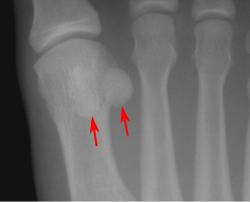
Back عظم سمسمي Arabic Sesamoid sümük Azerbaijani Сәсә һөйәктәре Bashkir Сезамовидна кост Bulgarian সিসাময়েড অস্থি Bengali/Bangla Sezamska kost BS Os sesamoide Catalan Sesambein German Sezamoido Esperanto Hueso sesamoideo Spanish
| Sesamoid bone | |
|---|---|
 Sesamoid bones at the distal end of the first metatarsal bone of the foot. | |
| Details | |
| Identifiers | |
| Latin |
|
| MeSH | D012716 |
| TA98 | A02.0.00.016 |
| TA2 | 374 |
| FMA | 32672 |
| Anatomical terms of bone | |
In anatomy, a sesamoid bone (/ˈsɛsəmɔɪd/)[1][2] is a bone embedded within a tendon or a muscle.[3] Its name is derived from the Greek word for 'sesame seed', indicating the small size of most sesamoids. Often, these bones form in response to strain,[4] or can be present as a normal variant. The patella is the largest sesamoid bone in the body. Sesamoids act like pulleys, providing a smooth surface for tendons to slide over, increasing the tendon's ability to transmit muscular forces.[3]
- ^ OED 2nd edition, 1989 as /sεsəmɔɪd/
- ^ Entry "sesamoid" in Merriam-Webster Online Dictionary.
- ^ a b "Sesamoid Injuries". aofas.org. Archived from the original on 2016-08-19. Retrieved 2014-12-06.
- ^ Saladin, Kenneth S. (2012). Anatomy and Physiology (6th ed.). New York: McGraw Hill. p. 234. ISBN 978-0-07-337825-1.
© MMXXIII Rich X Search. We shall prevail. All rights reserved. Rich X Search